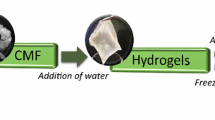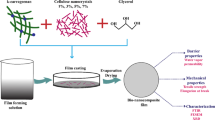Abstract
Biodegradable coatings and films of cellulose nanofibers (CNFs) or a combination of CNFs and inorganic fillers, such as clay or calcium carbonate (CaCO3), can provide a replacement for non-biodegradable plastic coatings as barrier layers in packaging boards. In this work, transparent composite films were prepared from CNFs of Pinus radiata and Eucalyptus using different amounts of clay and CaCO3 as fillers. The impact of raw material (softwood vs. hardwood), TEMPO oxidation levels and filler type (clay vs. CaCO3) on film properties was studied. Pinus radiata CNF films had superior mechanical properties to Eucalyptus CNF films, but no significant differences were observed in the barrier and optical properties. Clay seemed to work better as filler compared to CaCO3, in terms of its impact on film properties. Composite films with CaCO3 as filler were highly brittle with inferior properties to clay-CNF films, and an uneven distribution and agglomeration of the CaCO3 mineral particles was evident in SEM images. Based on the results, clay as filler in CNF coatings is preferred for targeting packaging board applications. Rheological characterisation of the CNF suspensions revealed shear-thinning behaviour, with the CNF from Eucalyptus having higher viscosities and lower power-law indices when compared to the CNF from P. radiata.







Similar content being viewed by others
Change history
18 September 2019
In the original version of this article, one of the concentrations of CNF suspensions has been reported to be 0.01% under the results and discussion of rheology measurements. It should have been 0.1% instead.
18 September 2019
In the original version of this article, one of the concentrations of CNF suspensions has been reported to be 0.01% under the results and discussion of rheology measurements. It should have been 0.1% instead.
References
Henriksson M, Henriksson G, Berglund LA, Lindström T (2007) An environmentally friendly method for enzyme-assisted preparation of microfibrillated cellulose (MFC) nanofibers. Eur Polym J 43:3434–3441
Lin N, Dufresne A (2014) Nanocellulose in biomedicine: current status and future prospect. Eur Polym J 59:302–325
Houga C, Meins JL, Borsali R, Taton D, Gnanou Y (2007) Synthesis of ATRP-induced dextran-b-polystyrene diblock copolymers and preliminary investigation of their self-assembly in water. Chem Commun 29:3063–3065
Lowys MP, Desbrières J, Rinaudo M (2001) Rheological characterization of cellulosic microfibril suspensions. Role of polymeric additives. Food Hydrocoll 15:25–32
Spoljaric S, Salminen A, Luong ND, Seppälä J (2014) Stable, self-healing hydrogels from nanofibrillated cellulose, poly (vinyl alcohol) and borax via reversible crosslinking. Eur Polym J 56:105–117
Stepan AM, Ansari F, Berglund L, Gatenholm P (2014) Nanofibrillated cellulose reinforced acetylated arabinoxylan films. Compos Sci Technol 98:72–78
Siró I, Plackett D (2010) Microfibrillated cellulose and new nanocomposite materials: a review. Cellulose 17:459–494
Hamedi MM, Hajian A, Fall AB, Håkansson K, Salajkova M et al (2014) Highly conducting, strong nanocomposites based on nanocellulose-assisted aqueous dispersions of single-wall carbon nanotubes. ACS Nano 8:2467–2476
Kumar V, Bollström R, Yang A, Chen Q, Chen G et al (2014) Comparison of nano- and microfibrillated cellulose films. Cellulose 21:3443–3456
Sasso C, Zeno E, Petit-Conil M, Chaussy D, Belgacem MN et al (2010) Highly conducting polypyrrole/cellulose nanocomposite films with enhanced mechanical properties. Macromol Mater Eng 295:934–941
Aulin C, Salazar-Alvarez G, Lindström T (2012) High strength, flexible and transparent nanofibrillated cellulose-nanoclay biohybrid films with tunable oxygen and water vapor permeability. Nanoscale 4:6622–6628
Baez C, Considine J, Rowlands R (2014) Influence of drying restraint on physical and mechanical properties of nanofibrillated cellulose films. Cellulose 21:347–356
Fukuzumi H, Saito T, Iwata T, Kumamoto Y, Isogai A (2009) Transparent and high gas barrier films of cellulose nanofibers prepared by TEMPO-mediated oxidation. Biomacromolecules 10:162–165
Hansen NL, Blomfeldt TJ, Hedenqvist M, Plackett D (2012) Properties of plasticized composite films prepared from nanofibrillated cellulose and birch wood xylan. Cellulose 19:2015–2031
Kurihara T, Isogai A (2014) Properties of poly(acrylamide)/TEMPO-oxidized cellulose nanofibril composite films. Cellulose 21:291–299
Lee K, Tammelin T, Schulfter K, Kiiskinen H, Samela J et al (2012) High performance cellulose nanocomposites: comparing the reinforcing ability of bacterial cellulose and nanofibrillated cellulose. ACS Appl Mater Interfaces 4:4078–4086
Qing Y, Sabo R, Zhu JY, Agarwal U, Cai Z et al (2013) A comparative study of cellulose nanofibrils disintegrated via multiple processing approaches. Carbohydr Polym 97:226–234
Rodionova G, Saito T, Lenes M, Eriksen Ø, Gregersen Ø et al (2012) Mechanical and oxygen barrier properties of films prepared from fibrillated dispersions of TEMPO-oxidized Norway spruce and Eucalyptus pulps. Cellulose 19:705–711
Sehaqui H, Salajkova M, Zhou Q, Berglund LA (2010) Mechanical performance tailoring of tough ultra-high porosity foams prepared from cellulose I nanofiber suspensions. Soft Matter 6:1824–1832
Syverud K, Chinga-Carrasco G, Toledo J, Toledo PG (2011) A comparative study of Eucalyptus and Pinus radiata pulp fibres as raw materials for production of cellulose nanofibrils. Carbohydr Polym 84:1033–1038
Aulin C, Netrval J, Wågberg L, Lindström T (2010) Aerogels from nanofibrillated cellulose with tunable oleophobicity. Soft Matter 6:3298–3305
Li F, Biagioni P, Bollani M, Maccagnan A, Piergiovanni L (2013) Multi-functional coating of cellulose nanocrystals for flexible packaging applications. Cellulose 20:2491–2504
Minelli M (2010) Investigation of mass transport properties of microfibrillated cellulose (MFC) films. J Membr Sci 358(1):67–75
Österberg M, Vartiainen J, Lucenius J, Hippi U, Seppälä J et al (2013) A fast method to produce strong NFC films as a platform for barrier and functional materials. ACS Appl Mater Interfaces 5:4640–4647
Syverud K, Stenius P (2009) Strength and barrier properties of MFC films. Cellulose 16:75–85
Fang Z, Zhu H, Yuan Y, Ha D, Zhu S et al (2014) Novel nanostructured paper with ultrahigh transparency and ultrahigh haze for solar cells. Nano Lett 14:765–773
Hu L, Zheng G, Yao J, Liu N, Weil B et al (2013) Transparent and conductive paper from nanocellulose fibers. Energy Environ Sci 6:513–518
Nogi M, Iwamoto S, Nakagaito AN, Yano H (2009) Optically transparent nanofiber paper. Adv Mater 21:1595–1598
Zhu H, Xiao Z, Liu D, Li Y, Weadock NJ et al (2013) Biodegradable transparent substrates for flexible organic-light-emitting diodes. Energy Environ Sci 6:2105–2111
Liu A, Walther A, Ikkala O, Belova L, Berglund LA (2011) Clay nanopaper with tough cellulose nanofiber matrix for fire retardancy and gas barrier functions. Biomacromolecules 12:633–641
Wu C, Saito T, Fujisawa S, Fukuzumi H, Isogai A (2012) Ultrastrong and high gas-barrier nanocellulose/clay-layered composites. Biomacromolecules 13:1927–1932
Spence KL, Venditti RA, Rojas OJ, Pawlak JJ, Hubbe MA (2011) Water vapor barrier properties of coated and filled microfibrillated cellulose composite films. BioResources 6:4370–4388
Eichhorn SJ, Dufresne A, Aranguren M, Marcovich NE, Capadona JR et al (2010) Review: current international research into cellulose nanofibres and nanocomposites. J Mater Sci 45:1–33
Klemm D, Kramer F, Moritz S, Lindström T, Ankerfors M et al (2011) Nanocelluloses: a new family of nature-based materials. Angew Chem Int Ed 50:5438–5466
Lavoine N, Desloges I, Dufresne A, Bras J (2012) Microfibrillated cellulose—its barrier properties and applications in cellulosic materials: a review. Carbohydr Polym 90:735–764
Moon RJ, Martini A, Nairn J, Simonsen J, Youngblood J (2011) Cellulose nanomaterials review: structure, properties and nanocomposites. Chem Soc Rev 40:3941–3994
Paunonen S (2013) Strength and barrier enhancements of composites and packaging boards by nanocelluloses—a literature review. Nord Pulp Pap Res J 28:165–181
Nechyporchuk O, Belgacem MN, Pignon F (2014) Rheological properties of micro-/nanofibrillated cellulose suspensions: wall-slip and shear banding phenomena. Carbohydr Polym 112:432–439
Naderi A, Lindström T, Sundström J (2014) Carboxymethylated nanofibrillated cellulose: rheological studies. Cellulose 21:1561–1571
Chen P, Yu H, Liu Y, Chen W, Wang X et al (2013) Concentration effects on the isolation and dynamic rheological behavior of cellulose nanofibers via ultrasonic processing. Cellulose 20:149–157
Rezayati Charani P, Dehghani-Firouzabadi M, Afra E, Shakeri A (2013) Rheological characterization of high concentrated MFC gel from kenaf unbleached pulp. Cellulose 20:727–740
Karppinen A, Saarinen T, Salmela J, Laukkanen A, Nuopponen M et al (2012) Flocculation of microfibrillated cellulose in shear flow. Cellulose 19:1807–1819
Pahimanolis N, Hippi U, Johansson L, Saarinen T, Houbenov N et al (2011) Surface functionalization of nanofibrillated cellulose using click-chemistry approach in aqueous media. Cellulose 18:1201–1212
Iotti M, Gregersen Ø, Moe S, Lenes M (2011) Rheological studies of microfibrillar cellulose water dispersions. J Polym Environ 19:137–145
Agoda-Tandjawa G, Durand S, Berot S, Blassel C, Gaillard C et al (2010) Rheological characterization of microfibrillated cellulose suspensions after freezing. Carbohydr Polym 80:677–686
Saarinen T, Lille M, Seppälä J (2009) Technical aspects on rheological characterization of microfibrillar cellulose water suspensions. Annu Trans Nord Rheol Soc 17:121–128
Pääkkö M, Ankerfors M, Kosonen H, Nykänen A, Ahola S et al (2007) Enzymatic hydrolysis combined with mechanical shearing and high-pressure homogenization for nanoscale cellulose fibrils and strong gels. Biomacromolecules 8:1934–1941
Saito T, Kimura S, Nishiyama Y, Isogai A (2007) Cellulose nanofibers prepared by TEMPO-mediated oxidation of native cellulose. Biomacromolecules 8:2485–2491
Liu J, Korpinen R, Mikkonen K, Willför S, Xu C (2014) Nanofibrillated cellulose originated from birch sawdust after sequential extractions: a promising polymeric material from waste to films. Cellulose 21:2587–2598
Moberg T, Rigdahl M, Stading M, Levenstam Bragd E (2014) Extensional viscosity of microfibrillated cellulose suspensions. Carbohydr Polym 102:409–412
Saito T, Isogai A (2004) TEMPO-mediated oxidation of native cellulose. The effect of oxidation conditions on chemical and crystal structures of the water-insoluble fractions. Biomacromolecules 5:1983–1989
Dang Z, Zhang J, Ragauskas AJ (2007) Characterizing TEMPO-mediated oxidation of ECF bleached softwood kraft pulps. Carbohydr Polym 70:310–317
Spence K, Venditti R, Rojas O, Habibi Y, Pawlak J (2010) The effect of chemical composition on microfibrillar cellulose films from wood pulps: water interactions and physical properties for packaging applications. Cellulose 17:835–848
Herrera-Alonso JM, Marand E, Little JC, Cox SS (2009) Transport properties in polyurethane/clay nanocomposites as barrier materials: effect of processing conditions. J Membr Sci 337:208–214
Aulin C, Gällstedt M, Lindström T (2010) Oxygen and oil barrier properties of microfibrillated cellulose films and coatings. Cellulose 17:559–574
Acknowledgement
Bioforest S.A. is gratefully acknowledged for the financial support.
Author information
Authors and Affiliations
Corresponding author
Electronic supplementary material
Below is the link to the electronic supplementary material.
Rights and permissions
About this article
Cite this article
Honorato, C., Kumar, V., Liu, J. et al. Transparent nanocellulose-pigment composite films. J Mater Sci 50, 7343–7352 (2015). https://doi.org/10.1007/s10853-015-9291-7
Received:
Accepted:
Published:
Issue Date:
DOI: https://doi.org/10.1007/s10853-015-9291-7




